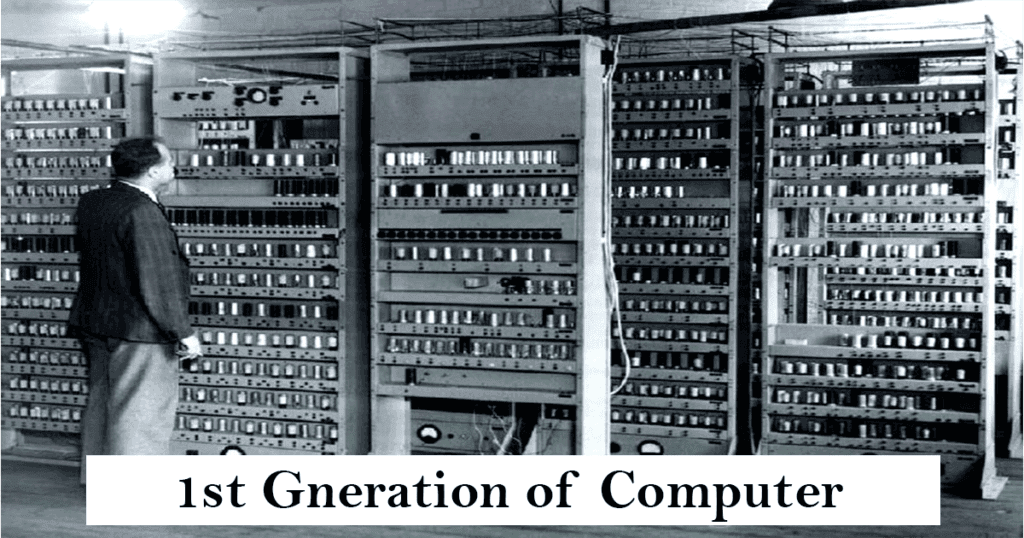The “1st generation of computer” refers to the introduction of electronic computing devices from the late 1940s to the mid-1950s. These pioneering machines used vacuum tubes for processing and data storage. Despite their significant size, high cost and power consumption, they represented a revolutionary leap in technology. The first generation of computers laid the groundwork for later advances and played a significant role in shaping the modern digital age. -“1st generation of computer”
What is the 1st Generation of Computers?
Definition and Characteristics
The first generation of computers refers to the initial phase of electronic computing devices, which emerged in the late 1930s and continued through the mid-1950s. These computers were characterized by their enormous size, complex vacuum tube-based circuitry, and reliance on punched cards for input and output operations. Unlike modern computers, they lacked microprocessors and were programmed using Low-level assembly languages.
Key Innovations and Components
The birth of the first generation of computers was marked by a number of unprecedented innovations. One of the most important achievements was the development of the Vacuum tube, a vital electronic component that allowed these machines to perform logical operations and calculations. Additionally, punched cards were Employed as a means of data Input, with each card representing a specific piece of information or instruction. – “1st generation of computer”
Development and Evolution of 1st Generation of Computers
ENIAC
The Electronic Numerical Integrator and Computer (ENIAC), completed in 1945, is often considered the first fully electronic general-purpose computer. Built during World War II to aid in complex calculations for military applications, ENIAC weighed over 27 tons and took up an entire room. Despite its size and limited memory, the ENIAC revolutionized computation and set the stage for future advances.
UNIVAC I
Following the success of ENIAC, the Universal Automatic Computer I (UNIVAC I) was introduced in 1951. The UNIVAC I was the first commercially available computer and gained fame for accurately predicting the outcome of the 1952 presidential election. Its capabilities to process large amounts of data and perform Complex tasks have marked significant advances in the field of computing.
EDVAC and EDSAC
In parallel with the development of ENIAC and UNIVAC I, other pioneering computers such as the Electronic Discrete Variable Automatic Computer (EDVAC) and the Electronic Delay Storage Automatic Calculator (EDSAC) were being built. These machines introduced the concept of stored programs, Which enabled users to modify instructions and perform various tasks without Physical rewiring. -“1st generation of computer”
Limitations of 1st Generation of Computers
Size and Space Requirements
One of the most Obvious drawbacks of first generation computers was their enormous size and space requirements. These machines required huge rooms to accommodate their complex Components, making them impractical for personal or Commercial use.
Heat and Power Consumption
The extensive use of vacuum tubes in first generation computers resulted in significant heat generation, requiring elaborate cooling systems to prevent overheating. Additionally, these machines consumed Large amounts of electricity, which increased the cost of electricity.
Lack of Portability
Due to their enormous size and weight, first generation computers lacked portability. They were immobile and inaccessible to the public, reserved primarily for government, military, and scientific purposes. -1st generation of computer”
Contributions and Impact of 1st Generation of Computers
Advancements in Science and Engineering
The advent of first generation computers revolutionized scientific research and engineering. These machines enabled complex calculations and Simulations, which greatly accelerated scientific discoveries and Technological progress.
Military Applications
During World War II, first generation computers played an important role in various military Operations. These were used for codebreaking, Ballistic calculations, and other important Wartime tasks.
Birth of Modern Computing
The advent of the first generation computers marked the beginning of modern computing. The concepts and innovations introduced during this era laid the foundation for the rapid development of Subsequent computer generations.
Transition to 2nd Generation Computers
As the limitations of first generation computers became apparent, researchers and engineers worked tirelessly to overcome these challenges. The development of the transistor to replace vacuum tubes paved the way for the second generation of computers, which were smaller, Faster, more reliable, and energy-efficient.
Conclusion
The first generation of computers stand as a testament to human ingenuity and determination to explore the unknown realms of computing. Despite their limitations, these early machines set the stage for the remarkable technological advances we see today. From their massive frames to the development of Vacuum tubes and punched cards, each aspect played a significant role in shaping the world of modern Computing.

